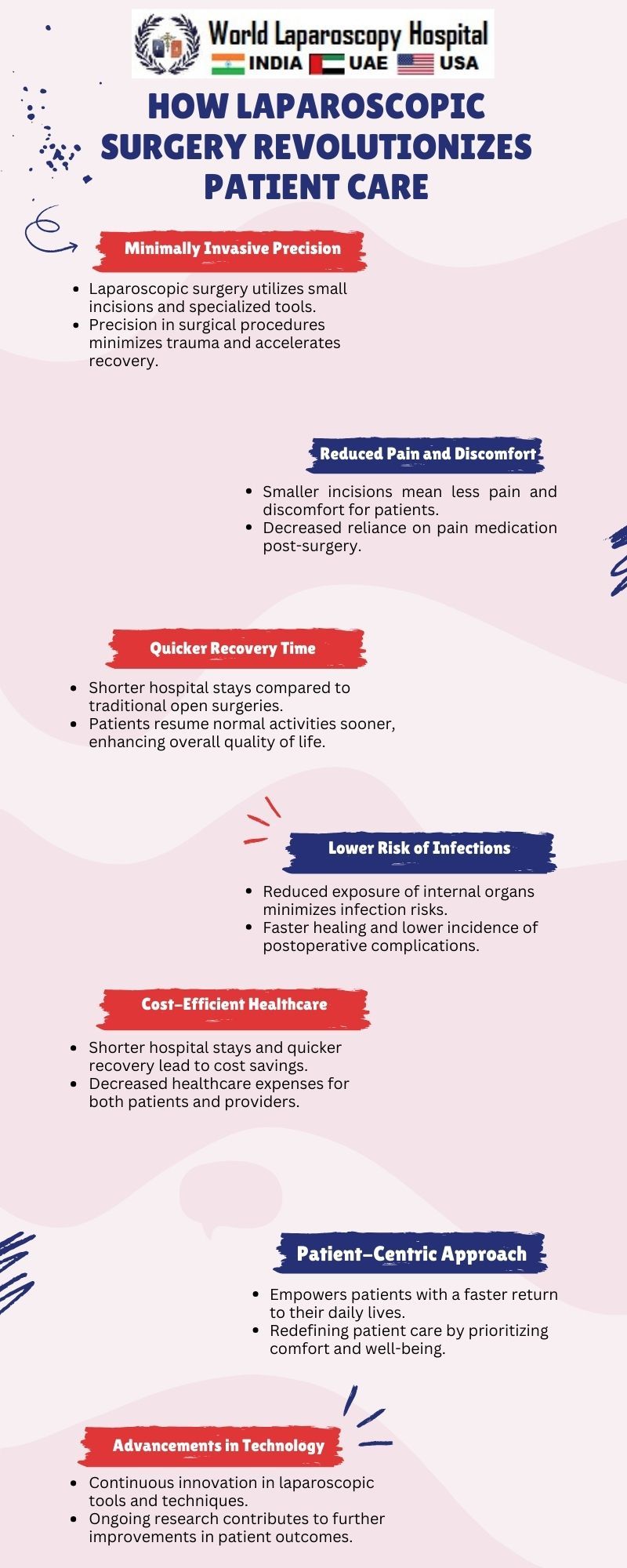How Laparoscopic Surgery Is Redefining Patient Care
Introduction:
In the realm of modern medicine, laparoscopic surgery has emerged as a groundbreaking approach that is redefining patient care. This innovative technique, also known as minimally invasive surgery (MIS), has revolutionized the landscape of surgical procedures across various medical specialties. Unlike traditional open surgeries that involve large incisions, laparoscopic surgery utilizes small incisions and advanced technology to access and treat internal organs with unprecedented precision.

Historical Context:
To understand the significance of laparoscopic surgery, it's crucial to explore its historical roots. The concept of minimally invasive surgery dates back to the early 20th century, with the development of endoscopy. However, it was not until the late 20th century that laparoscopic surgery gained widespread acceptance. The first laparoscopic cholecystectomy, a procedure to remove the gallbladder, was successfully performed in 1987, marking a pivotal moment in the evolution of surgical techniques.
Key Components of Laparoscopic Surgery:
Small Incisions:
One of the defining features of laparoscopic surgery is the use of small incisions, typically ranging from 0.5 to 1.5 centimeters. These incisions serve as entry points for specialized instruments and a camera-equipped laparoscope, allowing surgeons to visualize the surgical site with high-definition imaging.
Laparoscope:
The laparoscope, a thin, flexible tube equipped with a light source and a camera, plays a central role in laparoscopic procedures. This instrument is inserted through one of the small incisions, providing real-time, magnified images of the internal organs on a monitor. This visual guidance enables surgeons to navigate and manipulate tissues with precision.
Specialized Instruments:
Laparoscopic surgeries involve a set of specialized instruments designed for minimally invasive access. These instruments, operated through additional small incisions, mimic the dexterity of a surgeon's hand, allowing for intricate maneuvers and fine-tuned procedures.
Advantages of Laparoscopic Surgery:
Reduced Trauma and Scarring:
Traditional open surgeries often result in significant trauma to surrounding tissues, leading to extended recovery times and visible scars. Laparoscopic surgery minimizes trauma by using small incisions, reducing the risk of infections and promoting faster healing. Patients benefit from smaller, cosmetically appealing scars compared to traditional approaches.
Quicker Recovery and Shorter Hospital Stays:
The minimally invasive nature of laparoscopic surgery translates into shorter recovery periods for patients. Reduced postoperative pain and a lower risk of complications contribute to a faster return to normal activities. Additionally, the shorter hospital stays associated with laparoscopic procedures alleviate the burden on healthcare resources and decrease healthcare costs.
Less Blood Loss:
The precise control offered by laparoscopic instruments minimizes blood loss during surgery. This advantage is particularly significant in procedures involving vascular structures, where maintaining blood volume is crucial for patient safety.
Improved Cosmetic Outcome:
The cosmetic outcome of laparoscopic surgery is a notable benefit for many patients. Smaller incisions result in less visible scarring, addressing aesthetic concerns and enhancing patient satisfaction.
Applications Across Medical Specialties:
Gastrointestinal Surgery:
Laparoscopic techniques have become standard in gastrointestinal surgeries, including cholecystectomy, appendectomy, and procedures for inflammatory bowel disease. These applications have transformed the management of common digestive disorders, offering patients less invasive options with quicker recovery times.
Gynecological Surgery:
Gynecological procedures such as hysterectomy, ovarian cyst removal, and endometriosis treatment have embraced laparoscopic surgery. The minimally invasive approach in gynecology reduces the impact on reproductive organs, preserving fertility and improving overall patient outcomes.
Urological Surgery:
Laparoscopic surgery has found applications in urology, with procedures like nephrectomy and prostatectomy being performed using minimally invasive techniques. These advancements contribute to reduced postoperative pain and faster return to normal urinary function.
Orthopedic Surgery:
While traditionally associated with soft tissue surgeries, laparoscopic techniques are making inroads into orthopedic procedures. Minimally invasive approaches are being explored for joint surgeries, fracture fixation, and spinal interventions, promising benefits such as smaller incisions, reduced tissue damage, and faster recovery in the orthopedic domain.
Challenges and Considerations:
Learning Curve:
The adoption of laparoscopic techniques requires surgeons to undergo specialized training due to the unique skills and hand-eye coordination required. The initial learning curve may pose challenges for some practitioners, emphasizing the importance of structured training programs.
Equipment Costs:
The specialized equipment and instruments used in laparoscopic surgery can be expensive. While the long-term benefits in terms of patient outcomes and reduced healthcare costs are evident, the initial investment can be a barrier for healthcare institutions, particularly in resource-constrained settings.
Patient Selection:
Not all patients are suitable candidates for laparoscopic surgery. Factors such as the patient's overall health, the complexity of the procedure, and the surgeon's expertise play a role in determining the appropriateness of a minimally invasive approach. Careful patient selection is crucial for optimizing outcomes.
Future Trends and Innovations:
Robot-Assisted Surgery:
The integration of robotic systems into laparoscopic surgery is a promising avenue for enhancing precision and dexterity. Robot-assisted surgery allows for more intricate movements and improved ergonomics for surgeons, potentially expanding the scope of minimally invasive procedures.
Enhanced Imaging Technologies:
Ongoing advancements in imaging technologies, such as three-dimensional imaging and augmented reality, are poised to further enhance the visualization capabilities of laparoscopic surgery. These innovations have the potential to improve depth perception and spatial awareness, contributing to even more precise surgical interventions.
Expanded Applications in Complex Procedures:
As surgeons gain proficiency in laparoscopic techniques, there is a growing trend towards applying minimally invasive approaches to increasingly complex surgical procedures. This evolution may lead to a broader range of applications, offering patients less invasive options for conditions that were traditionally addressed through open surgeries.
Conclusion:
Laparoscopic surgery stands at the forefront of a transformative era in healthcare, reshaping the landscape of surgical interventions. Its numerous advantages, ranging from reduced trauma and quicker recovery to improved cosmetic outcomes, underscore its significance in enhancing patient care. As technological innovations continue to unfold and surgical techniques evolve, the future holds the promise of even more refined and expansive applications of laparoscopic surgery, solidifying its place as a cornerstone of modern medicine.


